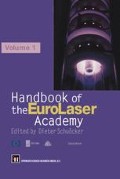Abstract
The efficient use of high power lasers for material processing depends on several properties of the laser beam. First of all the intensity must reach at least a million Watts per cm2 to achieve secure melting and evaporation of the workpiece, which are both necessary for nearly all production processes with lasers such as cutting, ablation, welding and coating. Secondly, the beam waist must have a diameter as small as a few tenths of a millimetre and the extension of the focused region, the so called Rayleigh length, must be at least several millimetres long to be able to obtain narrow processing paths and to achieve a reasonable depth of processing. To obtain this narrow beam waist and a low divergence, the radial beam mode must come as close as possible to the fundamental Gaussian distribution. Thirdly, the wavelength of the laser beam must be matched to the absorption properties of the workpiece material to avoid high reflectivity and to achieve an efficient production process. Therefore, for the treatment of metals, wavelengths up to one micrometre (μm) are most appropriate. Concerning the treatment of plastics, glass and similar materials, the wavelength of 10 μm is excellently suited. Finally, the overall power of the laser beam must be as large as possible, since for the treatment of thick workpieces the beam must be focused to a low divergence, what means in turn, that the beam waist diameter becomes rather large and therefore the necessary intensity mentioned above requires a high beam power.
Access this chapter
Tax calculation will be finalised at checkout
Purchases are for personal use only
Preview
Unable to display preview. Download preview PDF.
References
Bielesch, U., Budde, M., Fischbach, M., Freisinger, B., Schäfer, J.H., Uhlenbusch, J. and Viöl, W. (1992) A Q-switched Multikilowatt CO 2 Laser System Excited by Microwaves Proceedings of the SPIE: Gas Flow and Chemical Lasers, 1818, pp. 57–60
Breining, K., Pfeiffer, W., Giesen, A. and Hügel, H. (1994) Spatially resolved measurements in CO 2 laser active media Proceedings of the SPIE: Tenth international Symposium on Gas Flow and Chemical Lasers, 2502, pp. 542–547
Hall, D.R., and Baker, H.J. (1984) RF excitation of diffusion cooled and fast axial flow lasers Proceedings of the SPIE: Seventh International Conference on Gas Flow and Chemical Lasers, 1031, pp. 60–67
Hall, D.R., and Baker, H.J. (1994) Diffusion Cooled Large Surface area CO 2 /CO Lasers Proceedings of the SPIE: Gas Flow and Chemical Lasers, 2505, pp. 12–19
Hügel, H.E. (1986) RF excitation of high power CO 2 lasers Proceedings of the SPIE: High Power Lasers and Their Industrial Applications, 650 pp 2–9
Nowack, R., Opower, H. and Wessel, K. (1991) Diffusionsgekühlte CO 2 Hochleistungslaser in Kompaktbauweise, Laser und Optoelektronik 23, No. 3, pp. 68–81
Opower, H. and Schuöcker, D. (1993) Gaslaser,Patent No. DE 3810604 Al
Patel, C.K.N (1964) Selective excitation through vibrational energy transfer and optical maser action in N2 - CO2 Phys. Rev. Letts. 13, pp. 617
Schröder, K. (1990) Theoretical treatment of rf discharges in CO 2 waveguide lasers J.Appl.Phys. 68 (11), pp.5528–5531
Schuöcker, D. and Schröder, K. (1994) New strategies for the development of high power CO 2 lasers with beam powers up to 100 kW LANE 94, Oct. 12–14, Erlangen, Germany
Skolnik, M.I. (1970) Radar Handbook,McGraw Hill
Swysen, R. and Auer, M. (1990) Radial blower for gas circulation in a compact 2 kW CO 2 laser Proceedings of the SPIE: Lasers and Applications II, 1276, pp. 68–76
Tabata, N (1989) High Power Industrial CO 2 Lasers Proceedings of the SPIE: Gas Flow and Chemical Lasers
Walter, B. (1986) TEA CO 2 Lasers, physical problems and technical solutions Proceedings of the SPIE: High Power Lasers and Their Industrial Applications, 650 pp. 52–58
Walter, B. (1989) Impedance Matching of rf excited CO 2 lasers Proceedings of the SPIE, 1020
Wittemann (1987) The CO 2 Laser Springer Series in Optical Sciences, 53 Springer
Xin, J.G. and Hall, D.R. (1986) Multipass coaxial radio frequency discharge CO 2 lasers Opt. Commun, 58, pp. 420–422
Editor information
Editors and Affiliations
Rights and permissions
Copyright information
© 1998 Springer Science+Business Media Dordrecht
About this chapter
Cite this chapter
Schuöcker, D. (1998). Carbon dioxide lasers. In: Schuöcker, D. (eds) Handbook of the Eurolaser Academy. Engineering Lasers and Their Applications, vol 2. Springer, Boston, MA. https://doi.org/10.1007/978-1-4757-5383-7_3
Download citation
DOI: https://doi.org/10.1007/978-1-4757-5383-7_3
Publisher Name: Springer, Boston, MA
Print ISBN: 978-1-4757-5385-1
Online ISBN: 978-1-4757-5383-7
eBook Packages: Springer Book Archive

